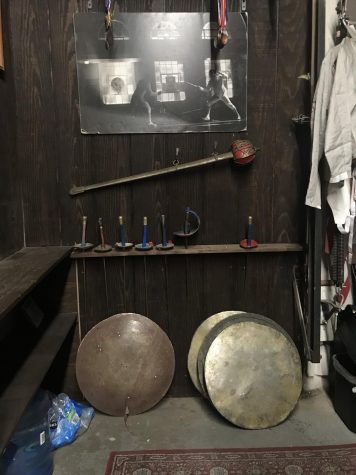Breaking a sweat with swords
Fencing provides a unique way to release stress while working out at the same time
Gearing up in the proper attire.
Before attending our first ever fencing class, senior Alin Aivazian and I had absolutely no idea what to expect. Since fencing is not a common sport, all our prior knowledge had come from movies and television, like the short fencing scene in The Parent Trap and the Fallen movie of 2017.
Fencing today may not be as popular as it used to be due to the expense involved and due to the fact that it is generally only practiced at boarding schools and not in public schools. However, according to Foxbusiness.com, fencing is the oldest Olympic sport, and U.S. competitors placed well in the 2016 Summer Olympics. The USA team made history as one member, Daryl Home, won silver after the team’s losing streak of 112 years.
Fencing is also a great a form of exercise, regardless of its current popularity. According to the LA Times, back in 1991 when the sport was more common, fencing was added into the curriculum of multiple public high schools. It was said to be good for relieving stress while building up physique at the same time.
Aivazian and I are both big believers in self-defense, but we wanted to approach self-defense in a more unique way. After a bit of researching, we came across Swordplay LA, a fencing school in Burbank where senior Jack Maruyama used to take lessons. “It was cool to learn something new, and Swordplay LA provided me with a fun way to learn about body coordination while allowing me to exercise my own body,” Maruyama said. “I went there for about one year.”
Aivazian and I attended an hour-long, private lesson there March 5. Being the top fencing school in the area, it was no surprise that the classes were not cheap; however, since it was our first time there, the owner and our instructor, Tim Weske, gave us a free-of-charge trial class.

There were different swords to choose from.
Walking into the studio felt like stepping through a time machine back into the medieval era. The whole place was dimly lit and built of dark brown and mahogany-colored wood. The walls were covered in swords, helmets, pictures from the medieval times, and medals won in competitions. The employees there were also extremely welcoming and there was no denying their passion for the sport.
We were first greeted by an instructor who was working at the front desk, Jacob Sayeedul. “I find fencing uniquely different, because it connects the mind with the body in a way where the sword becomes an extension of yourself,” Sayeedul said. He also informed us about our instructor and his remarkable achievements. “Tim [Weske] is your guy when it comes to fencing,” he said. “He has years of experience and he’s worked for and trained countless people in Hollywood.” Saydul, understanding that fencing is not extremely popular, believes that people should be more open to the sport, because although it may be expensive, it teaches a lot about life and the unrecognized talents of the human mind.
Weske started off our lesson with the basics of posture and footwork. He made us aware that the standing position is like a plié in ballet, something with which both Aivazian and I are familiar. He also taught us the different terms like en-garde and how to properly advance (to move towards your opponent), lunge (to move forward with one large step), and how to recover (to return back to an en-garde position after a lunge).
After that, he moved on to the different types of swords: the epee, the foil, and the saber. Since it was our first class we used the more basic weapon, the foil. After picking out our weapons and learning how to hold them, Weske fitted us into the appropriate attire: a cotton jacket, a standard mask and collegiate gloves. Once we were fully protected, he moved on to show us how to make smart attacks and counter attacks like a parry, a remise, a riposte and a feinte, or fake attack. He had us take turns practicing the moves against him for about 15 minutes before he allowed us to practice against each other.
Dueling each other was definitely something new for the both of us, but winning a round provided us with feelings of exhilaration and pride. “I’ve been a scout for most of my life, but I’ve never trained in such a cool way of self-defence before,” Aivazian said. “It’s obviously not a tactic one would use on an average day, but nonetheless I fell in love with its artistic appeal. I was forced to figure out different strategies for counter attacks, but once I had found one that worked it was easier for me to win.”
According to Rising Stars Fencing Academy, a fencing school in New Jersey, fencing is extremely beneficial when it comes to adolescent behavior “since fencing for kids is an independent sport, your child will learn how to work alone, and to take responsibility for their own successes or failures.” Also, since fencing is such a discipline-based sport, it helps improve children’s concentration skills. It requires them to learn all the moves and rules and then apply them skillfully in the time of competition. Fencing is also great for troubled kids, as “it can provide a channel to turn stress, anger and frustration into healthy competition.”
Mark Kazaryan, a former fencing coach in Armenia, started the sport when he was only six years old. He had a hard childhood and the discipline that sporting had provided him was exactly what he needed to keep his life on track. “I held in a lot of anger when I was a kid, and fencing helped me release that in the most beneficial way,” Kazaryan said. “I met a lot of people through the sport and my relationships with all of them held more meaning to me than the one I had with my actual family. Fencing saved my life.”














